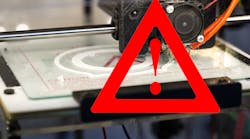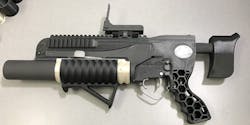Download this article in PDF format.
Many areas around the globe have some silly laws you must follow, or require permits in order to do things. For example, tasks like babysitting, tagging, holding garage sales, and even panhandling need a permit somewhere in the world. In fact, the FAA now demands that drone users register their craft, and depending on use, a license as well. Fines can run from $400 to $5,500, and the registrations don’t look like they’ll stop.
Chinese authorities in the city of Chongqing announced that 3D-printing companies must register their business with local police. This is so they can monitor the output from any of these companies for illegal or dangerous paraphernalia. Since most criminal activity seems to be occurring with personal printers, this really only hurts the 3D-printing industry in the region. Fortunately, I don’t see this becoming a trend.
Much of 3D printing is being done on prototypes for designs that may not be protected as of yet. This means, without complete control and non-disclosure agreements, companies will not want to take any prototyping to this region. While intellectual property is important, and the reason many companies don’t outsource to other countries, this would still keep companies within China from hiring a 3D-printing service company in this region.
3D-Printed Guns
In terms of reducing crime through 3D-printer registration, it likely won’t have much impact. Recently, a man was arrested in Japan for having five 3D-printed guns, two of which worked. With the increase of printing metals, and the dropping cost of metal printers, this will be as difficult as trying to monitor the trademarks with 3D printing. In addition, with so many DIY printers already out there, police will have to monitor the purchase of every small motor, Arduino, and extruded aluminum.
Controlling the 3D printing of guns is going to be just as complicated as gun control itself. The 3D printing of gun parts can help evade licensing and registrations, while an illegal weapon is being 3D printed out. However, the work involved to get to the point of holding a workable, full 3D-printed gun in your hand that wouldn’t fall apart after the first shot is harder than just getting a gun illegally or legally. Then someone still has to physically carry out the illegal act.
This hasn’t stopped the U.S. Army, though. They managed to 3D-print a grenade launcher, as well as the grenade itself. While this isn’t a basic print a civilian would use at home, it is enough to keep people worried from thinking anyone could do such a thing.
Researchers were able to fire 3D-printed ammo out of a 3D-printed grenade launcher.
3D-Printed Drugs
Another looming potential problem is perhaps of more concern than the gun issue. Drugs could very well be 3D-printed. Glasgow chemist Lee Cronin found a way to turn a 3D printer into a universal mixing chemistry set. Since most drugs are just mixes of carbon, hydrogen, oxygen, and perhaps a mix of paraffin and vegetable oil, a 3D printer could use these materials to print whatever you like. While the technology seems to be a bit off in the future, this is enough to worry people and the police. There are more present fears with 3D printing, too.
3D-Printed ID
The 3D printing of faces is apparently pretty easy to do. Just find a couple photos of yourself online, and there are companies that will 3D print a rendering of your face. These masks were accurate enough to fool facial-recognition software. As companies like Alibaba and Apple move to have your face connected to you, our bank account, and/or just about everything else, registering 3D printers, or having some Orwellian 1984-type monitoring software, might sound like a good idea to some people.
However, this also will not control crime. As the U.S. has seen in regards to security such as the TSA after 9/11 or gun control, many of the problems do not emanate from people following the laws and safety protocols. On top of that, trying to monitor home printers would simply be a mess. Having every printer fitted with software that monitors for contraband sounds too much like George Orwell’s 1984 for any politician to want to implement. So if we can’t control it, what can we do?
On the left is a 3D-printed mask of Matt Lewis, who is pictured on the right, which was used to try and fool facial-recognition software.
3D-printed faces have been proven to fool security, but software changes rapidly. With a few easy adjustments, it’s become near impossible to fool facial-recognition software with 3D-printed faces. Something as simple as asking for a person to blink before unlocking a device or program makes it exponentially harder for a person to hack this technology. Add thermal scans and infrared capabilities, and Apple thinks this is better than a fingerprint.
Macworld published the fact that “…Apple uses a combination of infrared emitter and sensor (which it calls TrueDepth) to paint 30,000 points of infrared light on and around your face. The reflection is measured, which allows it to calculate depth and angle from the camera for each dot. That lets it both create a kind of 3D fingerprint of your face that can used to compare against later…”
That made me wonder: “What about facial hair, glasses, or makeup changes?” Apple has already considered this, and said that the scan will penetrate sunglasses. So, if the user’s eyes are closed, the phone will not unlock. The user’s eyes must be open and looking at the phone to prevent people from unlocking your phone while you sleep and/or when you’re not actively engaged with the phone.
Fear Not
So while it is possible to 3D-print keys, guns, faces, or something else that might bypass security measures, there’s no reason to fear it. I often use automobiles and the internet as examples. Vehicles kill tens of thousands of people a year, but this has not stopped us from putting our children, or ourselves, into one and going about our day. Repeatedly, you hear reports of people and companies getting hacked online, but no one is crying to shut done the internet, or trying to find a way to only access the internet through a registered internet protocol.
It is more likely that someone will just hack into our bank accounts rather than go to the trouble of 3D printing a mask. Home security? Breaking a window, finding a hidden key, or finding an unlocked window is often easier than finding a copy of your key and 3D printing it. For that matter, if a person has a copy or replica of your key, automatic key-cutting machines would be easier than 3D printing. Here's how a 3D-printed key is made:
I’m reminded when a teacher told me chain wallets were banned in class for security purposes. I responded, “We have stainless-steel, 0.5-mm mechanical pencils, and heavy belt buckles that could easily be used to stab or hurt someone, but you’re worried about a chain that weighs maybe a few ounces!” I was suspended. While security is always a concern, I’d worry more about other things like health or having a strong password on your electronics.



